
The robotic revolution is underway! Micro robotics, an emerging field of research wherein cross-fusion of micro-technology and robotics takes place is fast paving the way for the development of robots that are smaller than a human hair. Yes, you read that right. From microbots that can walk, fly, swim, climb, crawl, and do various tasks like delivering drugs in our bodies, identifying cancers, destroying tumors; several innovations have been made around the globe.
To add to the march of these advanced inventions, scientists have also come up with micro-robots as small as less than 1 millimeter. Engineers and programmers around the globe are constantly working towards making advancements in this field and developing micro-robots that can’t be seen with the naked eye. All thanks to the latest advances in electronics, mechanics nanotechnology, and computing.
Out of the micro-robots being developed, some are emerging as incredibly useful tools, while others are designed and developed as creative ideas for further innovation in the field of micro-robotics. Here are the top 10 incredibly creative and advance micro-robots developed in 2020. These micro-bots are the results of superb engineering and are developed to solve many purposes; be it in the field of military, healthcare, or engineering. So without further ado, let’s check them out.
1. Laser-Activated Microscopic Robot
Researchers from Cornell and the University of Pennsylvania built microscopic robots comprising a simple circuit made from silicon photovoltaics especially the torso and brain part and four electrochemical actuators that work as legs. These laser-activated micro-robots are about 5 microns thick, 40 microns wide, and 40 to 70 microns in length. These tiny robots are controlled by flashing laser pulses at different photovoltaics, which helps charge a separate set of legs. To enable the robot to walk, the laser is toggled back and forth between the front and back photovoltaics.

2. Sea Creature Inspired Aqua Robot
Recently, Northwestern University researchers developed a life-like soft robot that can walk at a human speed, pick up the transport cargo to different locations, climb up the hills, dance, etc. Resembling a four-legged octopus, this micro-robot functions inside a water-filled tank and is ideal for use in aquatic environments. This minuscule, centimeter-sized aqua robot mimics the behavior of marine life and moves at a speed of one step per second. It is nearly 90% water by weight does not require complex hardware, hydraulics, or electricity for movement instead it is activated by light and walks in the direction of the external rotating magnetic field. The water-filled structure of this micro-robot and the embedded skeleton of aligned nickel filaments are ferromagnetic, thereby enabling precise movement and agility.

3. Bioinspired Micro-Robot
Taking inspiration from white blood cells, a team of scientists from the Max Planck Institute for Intelligent Systems (MPI-IS) in Stuttgart invented a tiny micro-robot that resembles a white blood cell traveling through the circulatory system. This micro-robot resembles leukocytes in shape, size, and moving capabilities. The ball-shaped drug-delivery robot can withstand the simulated blood flow. It spans every cell, offering an ideal route for navigation. The diameter of this microcontroller is under 8 micrometers and is made of glass microparticles. One side is covered with a thin nickel and gold film, the other with anti-cancer drug molecules and specific biomolecules that can recognize cancer cells. It has the coating of cell-specific antibodies on the surface and can release the drug molecules. In the laboratory setting, the microcontroller can reach a speed of up to 600 micrometers per second which is around 76 body lengths per second.

4. Lego-Like Magnetic Microbots
Eunhee Kim and Hongsoo Choi, two Engineers from Daegu Gyeongbuk Institute of Science and Technology in South Korea, and their colleagues built rectangular robots that can operate as nerve cell connectors, bridging gaps between two distinct groups of cells. Measuring 300 micrometers long and 95 micrometers wide, the tiny Lego-like magnetic microbots can hook up the brain cells (individual neurons) together to make a neural network.
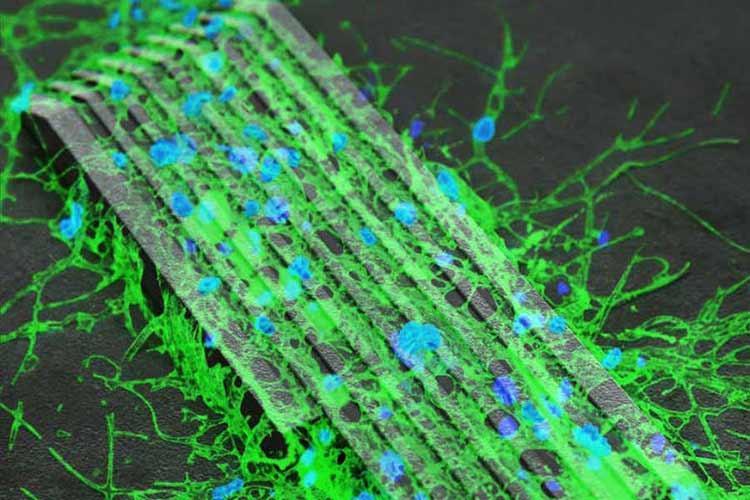
5. Miniscule Robots
Researchers at ETH Zurich have developed 3D printed micro-robots that are capable of delivering drug payloads via blood vessels in the human body. These micro-robots are so tiny that they can maneuver through our blood vessels and deliver medications to certain points in the body. The miniscule robots are created with a 3D printing technique that involves interlocking multiple materials in a complex way. Metals and polymers have different properties, and both materials offer certain advantages in building micro machines. Two materials i.e. metal and plastic are interlocked as closely as links in a chain.
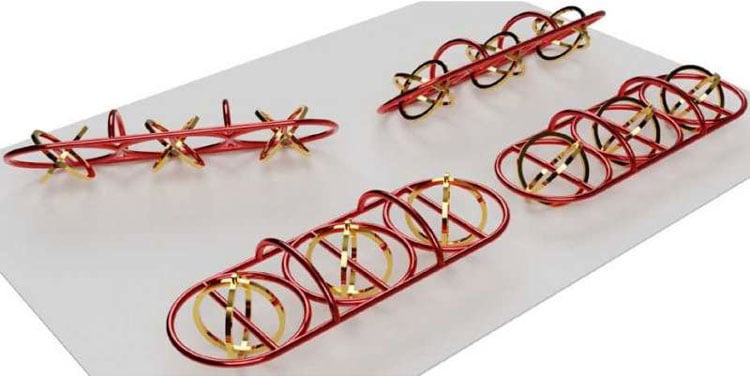
6. Harvard Ambulatory Microbot or HAMR-JR
Researchers at the Harvard John A. Paulson School of Engineering and Applied Sciences (SEAS) and the Harvard Wyss Institute for Biologically Inspired Engineering designed and programmed a cockroach-inspired robot, HAMR - JR. This penny-sized robot measures 2.25 centimeters in body length and weighs about 0.3 grams, and it can run about 14 body lengths per second.
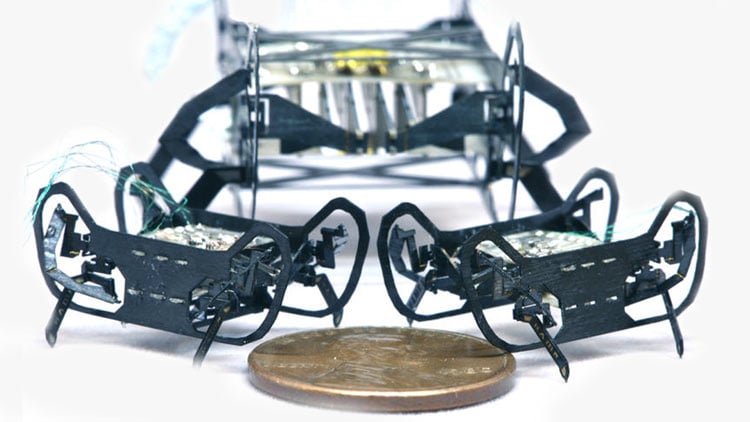
7. RoBeetle
RoBeetle is a tiny 88-milligram insect-sized autonomous crawling robot powered by the catalytic combustion of methanol. Developed by researchers at the University of Southern California, this tiny robot runs on methanol and uses an artificial muscle system to crawl, climb and carry loads on its back for up to two hours. The 15 millimeters (.6 inches) long RoBeetle uses an artificial muscle system based on liquid fuel (methanol) which stores about 10 times more energy than a battery of the same mass.
This micro robot has four legs. Its rear legs are fixed and the front legs are attached to a transmission which is connected to a leaf spring-tensioned in a way that pulls the legs backward. The body of the robot works as a fuel tank that is filled with methanol and the design is such that the robot can stand upright when still. The mechanical design of the system can modulate the flow of fuel using a purely mechanical system.
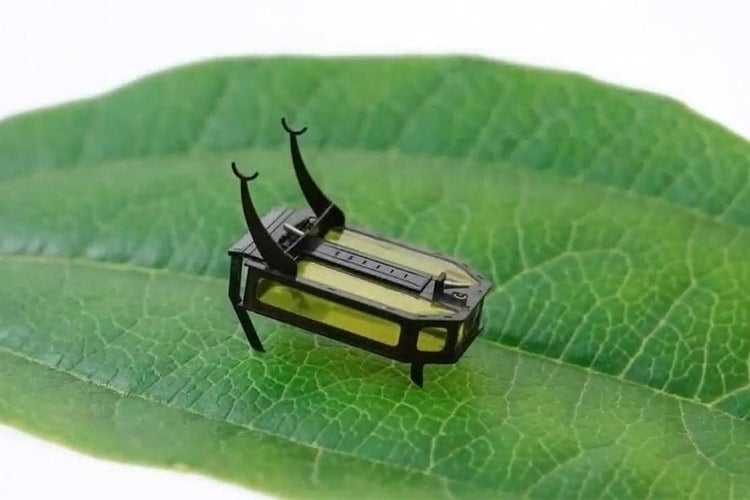
8. Magnetic T-Budbots
Researchers at ACS Applied Materials & Interfaces designed T-Budbots, biocompatible micromotors from tea buds to dislodge biofilms, release an antibiotic to kill bacteria and clean away the debris. The tiny bots can integrate antibiotic ciprofloxacin due to electrostatic interaction on their surface, thereby increasing their antibacterial efficacy against dreadful pathogenic bacterial communities of Pseudomonas aeruginosa and Staphylococcus aureus. Camellia sinensis tea buds are porous, non-toxic, inexpensive, and biodegradable. Moreover, the tea buds also contain polyphenols, which have antimicrobial properties.
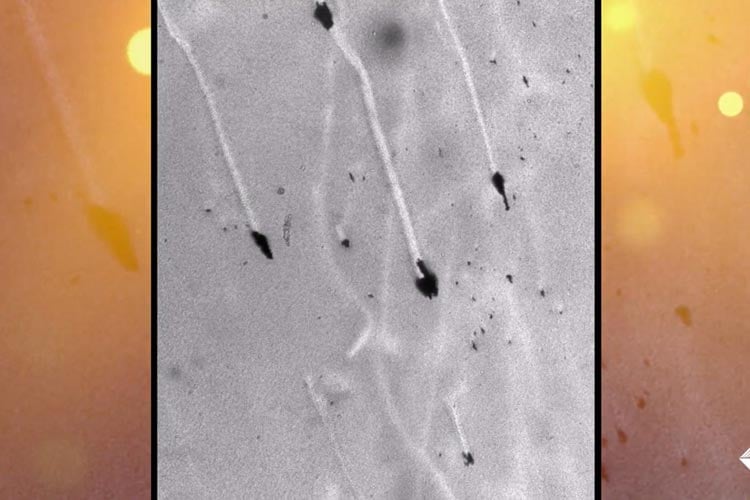
9. All-Terrain Microrobot
Engineers from Purdue University have developed an all-terrain microrobot as tiny as a few human hair strands. This microrobot can travel throughout a colon by doing backflips and transport drugs in humans with colons and other organs having rough terrain. The all-terrain robot is too small to carry a battery; therefore, it is powered and wirelessly controlled from the outside by a magnetic field.

10. RoboFly
Last but not the least, here is one named RoboFly. Researchers at the University of Washington have created this 74-mg flapping-wing microrobot that can move in the air, on the ground, and on water surfaces. This new robot was built using a lesser number of components compared to other insect-sized robots developed. This helped in simplifying the fabrication process. The design of this robot is such that the chassis has just a single folded laminate sheet.
RoboFly makes use of its two flapping wings driven by piezoelectric actuators to fly and hover as some insects do. It can move and steer on the ground by making use of the flapping wings. As the robot is light-weight, if modified with a set of three foot-like appendages, it can land on water surfaces. Upon landing, the robot can move and steer on water using the same principle that is used to move on the ground.
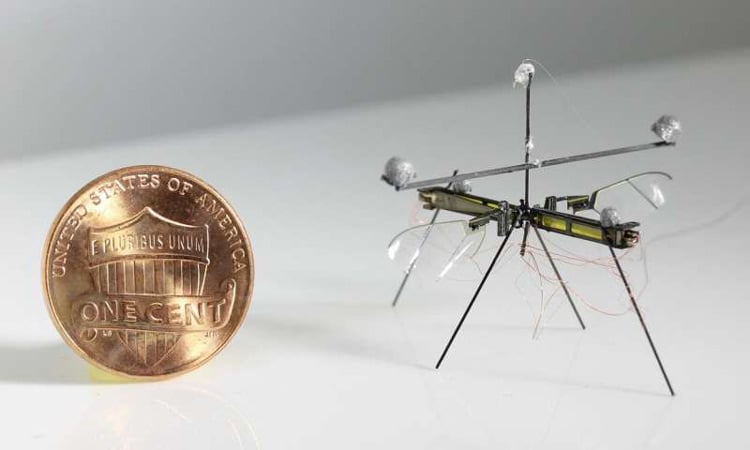
Haven’t these tiny robots left you amazed? Our list of micro-robots may not be complete as certainly there are more innovations taking place while we jot down these micro-robots, or we might have missed some of them, but the list will give you a pretty good idea of where the innovations in the field of micro-robotics stand today and in which direction it is going.





